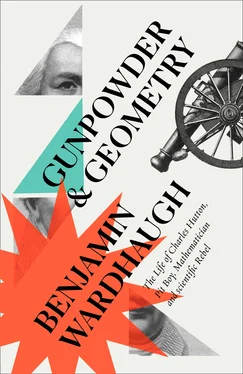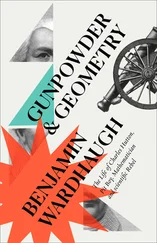As far as dangerous fun for boys went, this was infinitely more attractive than the classroom work, and the cadets were after all in training for a severely practical life as officers in the artillery or in some case the Engineers’ corps. On graduation at about eighteen most of the boys were at once commissioned as second lieutenants in the Royal Artillery regiment.
This, then, was the real stuff of an artillery officer. Cannon up to ten feet long and weighing up to three tons; iron balls moving at the speed of sound. Howitzers; mortars for lobbing shells high overhead. Roundshot, grapeshot, case-shot; explosive shells. The relentless drill of firing: four men at work, and every action had to be right every time or disaster would follow. Loader puts the charge down the muzzle, in its paper cartridge. Ventsman blocks the vent with his thumb, and spongeman rams the charge home. Ventsman pricks the cartridge, primes it with quickmatch in a tube pushed down the vent. Loader puts the projectile in the muzzle, spongeman rams it up against the charge. Run the gun up, point it at its target: traverse, align, adjust the elevation. Firer touches the vent with his portfire. The blast of several pounds of gunpowder, and an iron ball travels a thousand yards. Check the recoil. Spongeman sponges the barrel clear. Repeat. Furious speeds were possible; with a light gun seven rounds a minute could be achieved in an emergency: nine seconds from one shot to the next.
In alternate years the summer saw a full-scale attack upon a polygonal front built at Woolwich for the purpose, done ‘with all the form and regularity that is used in a real siege’. Trenches, batteries, mines made by the besieged to blow up the batteries, mines made by the besiegers to make breaches in the walls. Fortunately there was a well-equipped hospital on the site.
With all this going on, it may be no wonder there was a problem getting the boys to attend to their theoretical studies. Some of them at least itched to get away from the mathematics and the theory, and there were still in Hutton’s day at least some officers of the regiment who thought the whole Academy a waste of space. General Belford wished it disbanded, and in the late 1770s wrote a stinging letter to the Master-General of the Ordnance suggesting that instead ‘a number of fine young fellows [be] appointed as Cadets to every Battalion’, where they might do practical work and see real action.
He may have had a point. The long series of reforms and adjustments had made the Royal Military Academy an institution whose details were not easy to defend. Admittedly some kinds of knowledge were best acquired in a school-like setting, but why should an artillery officer need to know algebra, geometry, trigonometry?
But the training was not so much about what you needed to know as about producing a particular kind of man with a particular kind of mind. The Academy, unique and exceptional in some ways, was nevertheless part of a much more general eighteenth-century trend in English education. Mathematics and the sciences enjoyed increasing prestige at the English universities, with Cambridge in particular stuffing its curriculum full of Euclid and Newton to the oft-remarked exclusion of almost anything else. Newtonian mathematics, together with the philosophy of John Locke and the rational theology of such as Samuel Clarke, ‘went hand in hand through our public schools and lectures’, said one contemporary. Cambridge University’s official calendar, too, boasted specifically of the ‘many excellent lectures in mathematics’ delivered in the colleges. John Locke himself had written that mathematics was ‘a way to settle in the Mind an habit of Reasoning closely and in train … In all sorts of Reasoning, every single Argument should be managed as a Mathematical Demonstration.’ It enlarged the mind, instilled intellectual humility, and taught the habit of clarity in one’s ideas.
It was a similar picture at the so-called Dissenting Academies. These were advanced schools or mini-universities for those whose non-Anglican commitments excluded them from Oxford and Cambridge. By mid-century there were dozens of them, and they enjoyed a fine reputation, often teaching curricula based on mathematics and natural philosophy as well as logic and theology, sometimes with the specific intention of disciplining the mind, teaching logical thought and a reliance on pure reason.
So the Royal Military Academy was doing nothing very odd by filling its curriculum with more mathematics than any practical consideration demanded. It was doing what its managers and staff conceived as its clear duty: training and moulding young men in desirable mental as well as physical habits. Just as the duties of a gentleman officer required a knowledge of dance and a smattering of French, they required an acquaintance with the results and, more importantly, the methods of Euclid and Newton. It was a situation that suited Charles Hutton; in any debate about whether it was worth teaching boys geometry, algebra and the rest, there was no doubt which side he would take. Over the years he would become ever more committed to the cause of promoting mathematics, its usefulness and its beneficial effects on the mind. Indeed, the status and the national importance of mathematics would exercise him for much of the rest of his life in one forum or another.
As a teacher, meanwhile, he seems to have succeeded in catching the attention of the boys, and in winning them over to take seriously what he had to impart. His manner was cheerful, friends reported, but deliberate in expression; he himself reckoned gravity a part of his character. His voice was clear and firm, with a slight northern accent that he would keep to the end of his days. His mind (in good Lockean style), they said, was ‘accustomed to communicate its feelings with a sort of mathematical precision’. Hutton was remembered by his former students with respect, affection, even veneration. One cherished a commemorative medal of Hutton’s august profile to the end of his life. It was never Professor Hutton who got pelted in the street.

If the boys were won round to Hutton fairly rapidly, the staff were a tougher task. Pollock was going from bad to worse. The teaching staff were civilians; so, unlike an officer of the regiment, he couldn’t be court-martialled for disobedience. Reprimand after reprimand had no effect on his attendance or his willingness to deliver the course as the inspector conceived it: just more elaborate, sometimes legalistic excuses. He disputed the rules about where he was supposed to live, and the system by which certain parts of his pay were worked out. He disputed what he was supposed to be teaching and where the boundary lay between Hutton’s subject area and his own.
There was indeed a long-running question as to whether the curriculum should be determined by the Board of Ordnance (which paid for the Academy) or by the teachers who had to deliver it. And there was a more detailed question about how responsibility for the practical parts of mathematics – surveying and so on – should be divided between the Professor of Fortification and Artillery (Pollock) on the one hand and the Professor of Mathematics (Hutton) on the other. In both respects, sane compromises took some time to arrive at, and Pollock made himself increasingly ridiculous. Early in 1774 the inspector wished the more advanced boys to be shown how to take an angle of elevation with a theodolite or quadrant, and asked Pollock either to do it or to lend the instruments to Hutton. He refused ‘in a very haughty and imperious manner’ and added ‘that the Academy is not a fit place to mention those things’. He took to refusing to allow the inspector into his classroom, standing on a technicality in his written instructions.
Читать дальше













